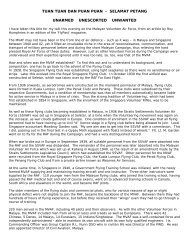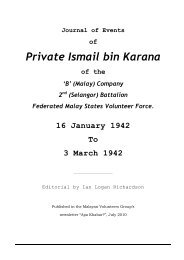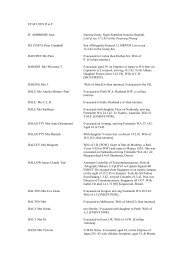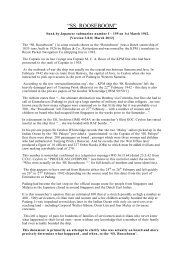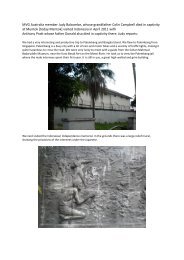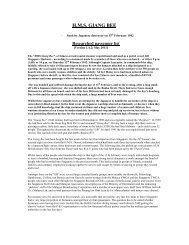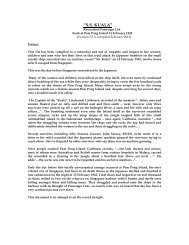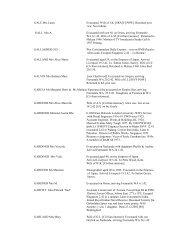SINGAPORE AND THE THAI RAILWAY EXPERIENCES OF ...
SINGAPORE AND THE THAI RAILWAY EXPERIENCES OF ...
SINGAPORE AND THE THAI RAILWAY EXPERIENCES OF ...
Create successful ePaper yourself
Turn your PDF publications into a flip-book with our unique Google optimized e-Paper software.
last legs, but had started to go down the hill again due to a relapse brought on by working in a<br />
drain being dug across the camp. Work started later on a huge dyke and ditch which went all<br />
around the camp - I worked for 3 or 4 days and then had a relapse of malaria. One day on this<br />
job we had a big daylight air raid on the railway bridge. There were 30 Liberators and it was<br />
the biggest raid we saw at N.P. They dropped six salvoes and did a good job, as we saw when<br />
later we moved from Tamuan to Bangkok. The Nips were terrified but we stood there and<br />
laughed at them, which did not appeal to them.<br />
36.<br />
Page 59<br />
An order was issued that POWs were not to laugh at the Nips when they ran to the air raid<br />
trenches. We had no slit trenches for ourselves till then but after the raid we dug trenches<br />
around each hut. At the full moon we had night raids and the planes would get their bearings<br />
from the pagoda or Wat in the town. This Wat was 400 feet high and an outstanding<br />
landmark in that flat paddy-growing plain. The outline of this Wat, which was tiled in golden<br />
tiles, was very striking, particularly with the sun setting behind it. This shape was something<br />
like this:-<br />
(Sketch) all this part covered in golden-coloured tiles.<br />
The planes at night bombed the railway at the port of Pak Nam - usually about 12 or 15 miles<br />
away. There were no raids whilst I was there on the aerodrome 1 mile outside the camp. On<br />
this<br />
Page 60<br />
'drome there were several old Thai biplanes which took off in the daylight air raids. They<br />
never attempted an attack however - they were more sensible. On one occasion 2 Nip Zero<br />
fighters used the drome. The most 'planes we saw was 54 coming back from a raid on<br />
Bangkok 50 miles away to the East.<br />
The Nips allowed us concerts after we had been in NP about 2 months. Before that we were<br />
not allowed any lectures, to whistle or sing. Of course, we had them and we also had plenty<br />
of quizzes, in which I often took part. Hugh Llewellyn of the APC was our word master for a<br />
while. There was a great change for the better in him. Before the war he was one of S‛pore's<br />
most unpopular young men, putting on airs and making himself objectionable. He had lost all<br />
of this and behaved splendidly - working most disinterestedly for camp welfare. He used to<br />
run the quizzes. Before the war he had adopted a pseudo-intellectual pose - he had dropped<br />
this, and he had worked hard - physically - in the improvement of the camp.<br />
Page 61<br />
N.P. was a very clean camp. We had several plagues of flies and every man made a fly whisk<br />
and killed at least 20 a day. There were prizes of extra "douvers", rice cakes about the size of<br />
a currant bun, for those catching most. Some turned in 700 or so flies daily. They would sit<br />
all day long on the cook house killing flies. The bed bug position was kept in control. At<br />
first the wooden plank floors harboured millions of them and sleep at night was impossible.<br />
But we took all the nails out (which we used for repairing our wooden slippers - trompers),<br />
and then took up the planks, killed the bugs by squeezing them, and then put the planks in the<br />
sun and that killed the small ones. Then we ran the planks through fires to kill the eggs.



